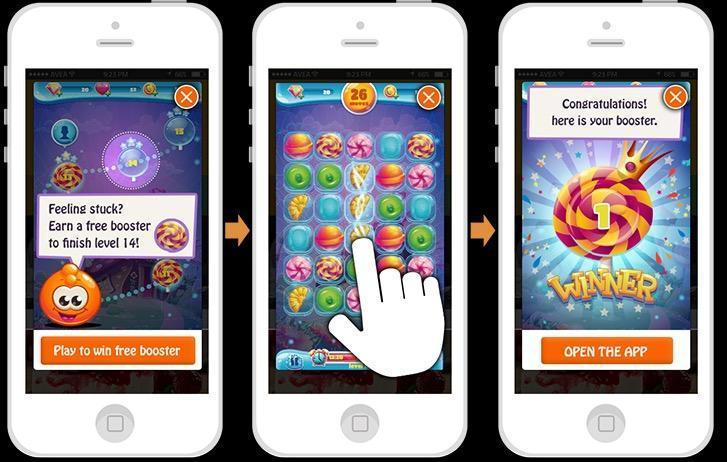
Looking to supercharge user engagement and drive a surge in app installs? You’re in the right place. Playable ads are transforming the digital marketing landscape, and today, we’re diving deep into how you can leverage them for maximum impact.
This guide will walk you through every step of creating compelling playable ads that captivate users from the moment they see them. From understanding why playable ads outperform traditional banners to prototyping with tools like Unity, and including all the crucial elements for maximum effectiveness, we’ve got you covered.
Table of Contents
- What Are Playable Ads?
- The Benefits of Playable Ads
- Steps to Create Playable Ads
- Best Practices for Creating Playable Ads
- FAQs About Playable Ads
- Conclusion
What Are Playable Ads?

Before we get into the details of creating playable ads, let’s first understand what they are. Playable ads, or “playables,” are a type of ad format that lets users try a scaled-down version of an app or game before they install it. This format offers a hands-on experience, allowing potential users to engage with the content directly. According to Singular, this interactive approach significantly increases user engagement and conversion rates. Research from Marketing Tech News confirms that playable ads drive 20 times more installs than banner ads, making them an effective advertising tool.
The Benefits of Playable Ads
Playable ads offer several advantages:
- Higher Engagement: Users can interact with the ad, making it more engaging.
- Better Conversion Rates: Playable ads are more likely to convert users into app installers.
- User Experience: They provide a preview of the app, ensuring that users know what they’re getting into.
- Reduced Uninstalls: Since users have already tried the app, they’re less likely to uninstall it later.
Steps to Create Playable Ads

Creating playable ads may seem daunting, but it can be broken down into manageable steps. Here’s a detailed guide to help you get started.
1. Define Your Objectives
Before you start, define what you want to achieve with your playable ad. Are you looking to increase app installs, drive brand awareness, or boost user engagement? Your objective will guide the entire ad creation process.
2. Choose the Right Platform
Different platforms offer various tools and resources for creating playable ads. For instance, Facebook and TikTok have specific guidelines and tools to help you design your ads.
3. Create a Prototype
Start by creating a prototype of your playable ad. This can be a simplified version of your app or game that highlights its core features. You can use tools like Unity, HTML5, or specialized ad creation software.
Example: Creating a Prototype with Unity
Unity is a popular choice for creating playable ads, especially for games. You can use Unity’s 2DKit to design a simple interactive ad. This involves creating an HTML.index file and ensuring that all necessary assets are inlined.
4. Develop the Playable Ad
Once your prototype is ready, move on to development. This involves coding the interactive elements and ensuring that the ad functions smoothly. If you’re using Unity, you can integrate Project Tiny, an official Unity library that minimizes the game’s resources.
5. Test Your Ad
Before launching, it’s essential to test your playable ad to ensure it works as intended. Test it on various devices and platforms to identify any issues. Make sure the ad is neither too hard nor too easy to engage users effectively.
6. Launch and Monitor
After testing, launch your playable ad on your chosen platform. Monitor its performance and make necessary adjustments to optimize its effectiveness.
Best Practices for Creating Playable Ads for mobile

To be successful, consider these practices:
Keep It Simple
Your ad should be easy to understand and engage with. Avoid overly complicated mechanics that might confuse users.
Optimize for Mobile
Most of them are viewed on mobile devices. Ensure that your ad is optimized for various screen sizes and resolutions.
Highlight Key Features
Focus on the most engaging aspects of your app or game. This will help capture users’ attention quickly.
Include a Clear Call-to-Action (CTA)
Your ad should have a clear and compelling CTA, encouraging users to download the app or take the desired action.
FAQs
1. How to make playable game ads?
- Interactive Video: Developers integrate video footage with HTML code. This approach is ideal for 3D or cinematic ads.
- HTML Video: Developers create playable game ads from scratch using HTML.
For more details, visit AppSamurai’s guide.
2. How much do playable ads cost?
The cost can vary. On Android, they cost less than half the price of native ads, averaging around $1.22. They are 20 times more likely to drive installs compared to banner ads.
For more information, check out Marketing Tech News.
3. How to create playable ads on Facebook?
Follow these steps:
- Go to Ads Manager and create a new campaign.
- Select the App promotion objective.
- Click edit next to App promotion campaign types and select App Ads.
- Choose an app you want to promote before uploading a playable source file.
- In the Placements section, choose your placements.
For a detailed guide, visit Meta Business Help Center.
4. How can I create playable ads without any company’s tool in Unity?
If you prefer not to use a company’s tool, you can download official Unity tools and examine their code. Alternatively, use a proxy to scan and understand how existing they are built.
Conclusion
Creating playable ads can be a highly effective way to engage users and drive app installs. By following the steps outlined in this guide, you can develop compelling and interactive ads that capture users’ attention. Remember to keep it simple, optimize for mobile, and include a clear CTA.
Thank you for taking the time to read this comprehensive guide. We hope you found it informative and helpful. If you have any questions or need further assistance, please don’t hesitate to reach out.




